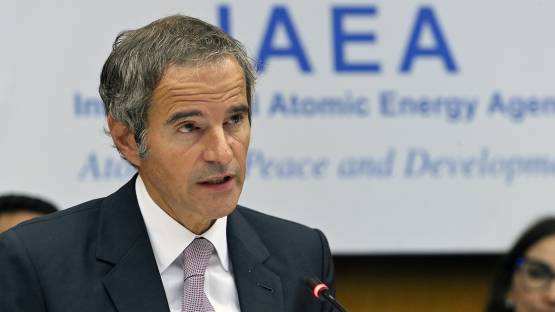
IAEA Director General Rafael Mariano Grossi. (Photo: D. Calma/IAEA)
Mr Chairperson,
Just a few days ago I led the IAEA Support and Assistance Mission to Ukraine’s Zaporizhzhya Nuclear Power Plant (ISAMZ). ISAMZ established a continuous IAEA presence at the site to help ensure nuclear safety and security and allowed inspectors to undertake vital safeguards activities.
The mission made clear the urgent and imperative goal of halting the shelling that is hindering the safe operation of the Zaporizhzhya NPP. A nuclear safety and security protection zone is urgently needed and I have begun initial consultations with the relevant Parties. The protection zone is essential to end the repeated shelling of the Plant and of the off-site power infrastructure crucial for reactor cooling and other systems needed to maintain safety now that all reactors at Zaporizhzhya NPP are in shutdown.
Before, I give you a brief overview of the other findings and recommendations, I would like to thank you for your support of the mission, which was made possible only after painstaking efforts over the past six months.
A report on the work of the IAEA in assisting Ukraine and assessing the situation at its nuclear facilities is before the Board. It includes the latest information and recommendations by ISAMZ. It follows two public reports, the most recent one published last week, and my oral report to the Board this past June.
The mission’s assessments and recommendations follow the IAEA’s seven pillars of nuclear safety and security.
I have already addressed the first safety pillar that exists in any nuclear facility, which is that its physical integrity must not be violated. My team of experts and I were able to see the highly concerning consequences and the near misses of the attacks on the plant. Continued shelling increases the risk of a nuclear accident and I urge all parties to agree and implement a safety and security zone immediately.
The second pillar states that all safety and security systems and equipment should be fully functioning, operating normally and unhindered. At Zaporizhzhya NPP, we observed violations of this with military equipment and vehicles getting in the way of this important pillar being maintained. We recommend that the military vehicles currently present inside the buildings and around the buildings be removed so they do not interfere with the operation of the safety and security systems.
The third pillar states that operating staff must be able to perform their duties without undue pressure or duress. This is an issue that has been raised many times since the Russian occupation of the Zaporizhzhya NPP began in March. It has led us to the recommendation that the operator should be allowed to return to working within its clear and routine lines of responsibilities and authority, and that an appropriate work environment must be established, including proper support for staff and their families.
Pillar four refers to the importance of maintaining a constant off-site power supply so as not to lose crucial functionalities, including the cooling of reactors and spent fuel. Though off-site power is again reaching the Plant, the frequent interruptions caused by shelling remain a serious concern, especially now that the entire Plant is in shutdown. All military activities that may affect the power supply systems must cease immediately, which is why we are working hard on getting the protection zone agreed and established.
The fifth pillar states there must be uninterrupted supply chains and transportation to and from the site. This is crucial also to transport diesel to and from the site in case back-up generators are needed again. All parties must ensure such uninterrupted movement of supplies. The IAEA stands ready to support the Zaporizhzhya NPP as it has done at the Chornobyl NPP and its Exclusion Zone, where supply chains have been re-established and some equipment has been delivered via the IAEA.
The sixth pillar states there must be effective on-site and off-site radiation monitoring systems and emergency preparedness and response measures.
While on site, we observed that radiation monitoring systems provide incomplete data and that some equipment has been damaged by shelling. Moreover, the nuclear power plant no longer has an emergency centre or communications system fit for purpose. Furthermore, the essential communication links between that limited on-site emergency centre and the off-site emergency centre that manages and coordinates any countermeasures required to protect the local population in the event of an accident has been undermined and citizens living in the Russian occupied territories near the plant have been called to evacuate. We recommend the urgent remediation of the shortcomings in the radiation monitoring systems and emergency preparedness and response measures.
The seventh and final pillar states there must be continued and reliable communication with the regulator and others. At Zaporizhzhya NPP, communications channels have been interrupted, and in some cases severed. Therefore it is our recommendation that reliable and secure communication channels that have adequate levels of redundancy be re-established.
Despite the ongoing challenges of the war, we have continued to implement safeguards in Ukraine. During ISAMZ, safeguards inspectors were able to conduct essential verification activities at the two reactors that underwent refuelling. We will continue to implement safeguards taking into consideration the safety and security situation in Ukraine. Based on the evaluation of all safeguards-relevant information available to the IAEA, we have not found any indication that would give rise to a proliferation concern.
Mr Chairperson,
Our historic IAEA mission has provided the international community with an important, deeper and clearer understanding of the situation at Zaporizhzhya NPP. The ongoing presence of the IAEA at the site allows us to provide impartial, reliable, clear and timely information and assessment of what is happening at Ukraine and Europe’s biggest nuclear power plant. In the past, IAEA experts and inspectors arrived on the ground in the aftermath of difficult situations, such as the accident in 2011 at the Fukushima Daiichi Nuclear Power Station. ISAMZ is a proactive mission aimed at preventing an accident that could have serious consequences, particularly for those working and living near Zaporizhzhya NPP. Through our ongoing presence and the implementation of a nuclear safety and security protection zone, we have the opportunity to reduce the risk of an accident; improve the conditions under which the staff of Zaporizhzhya NPP operate the plant; and lay part of the foundation necessary for the road to peace and security.
I would like to again express my gratitude to you, distinguished Members of the Board, for your ongoing support of this mission. I also thank and commend the team who travelled with me, especially the 2 individuals currently at Zaporizhzhya NPP, for their commitment to the IAEA’s mandate and the indispensable job the Agency is doing in Ukraine.
Mr Chairperson,
The IAEA’s technical assistance programme remains an important vehicle by which Ukraine can request assistance and Member States in the position to do so can offer it. Through this programme, the IAEA made the first delivery of essential equipment to Ukraine in July. It included a large batch of radiation protection and monitoring equipment, as well personal protective equipment and other items to mitigate the possible consequences of a nuclear accident or a radiological emergency.
I would like to thank the 12 Member States registered in RANET for their efforts in identifying the equipment they could offer in response to Ukraine’s requests and for their close collaboration with us to get it delivered. I am also grateful to the 11 donors from Member States and one international organization that made available, or expressed interest in making available, extrabudgetary contributions to support the provision of assistance to Ukraine in nuclear safety, security and safeguards. More safety and security-related equipment will be transported to Ukraine in the coming months. The needs of Ukraine are substantial, and I encourage other countries also to step forward with support.
The IAEA stands ready to further extend its scope of the technical assistance based on Ukraine needs and I am committed to using every possible mechanism to deliver it efficiently.
Mr Chairperson,
My report on Nuclear and Radiation Safety provides a detailed update on our recent work in nuclear; radiation; transport and waste safety; emergency preparedness and response; and civil liability for nuclear damage.
During the reporting period, the Agency published 2 General Safety Guides and 12 Specific Safety Guides; additionally, 22 draft safety guides were endorsed by the Commission on Safety Standards for submission for publication, as the Secretariat implemented the Action Plan adopted in April 2021, which aims to clear the backlog of safety standards awaiting publication.
In June to July this year, the Agency held the Seventh Review Meeting of the Contracting Parties to the Joint Convention on the Safety of Spent Fuel Management and on the Safety of Radioactive Waste Management to present, discuss and review National Reports, and to address the measures taken by Contracting Parties to implement the obligations of the Convention. Four Member States became new Contracting Parties to the Joint Convention, bringing the total number of Contracting Parties to 88.
I would like to highlight that as of today, 141 States have made a political commitment to implement the Code of Conduct on the Safety and Security of Radioactive Sources. In addition, 124 and 45 States have expressed support to the supplementary Guidance on the Import and Export of Radioactive Sources and the Guidance on the Management of Disused Radioactive Sources, respectively.
My report on Nuclear Security, which you have before you and which for the first time follows the same approach as the report on Nuclear and Radiation Safety. This report covers activities undertaken by the Agency in the area of nuclear security, highlights significant accomplishments within the framework of the Nuclear Security Plan, and is complemented by the Nuclear Security Review which was produced for the first time this year and presented to the Board in June.
Also in June, the 11th Meeting of the Representatives of Competent Authorities identified under the Early Notification and Assistance Conventions adopted a robust Action Plan of recommendations and action items to strengthen national, regional and international infrastructures and State Parties’ capacities to address newly arising and complex situations that challenge the response to nuclear and radiological emergencies.
IAEA missions are indispensable to assisting Member States in implementing safety standards and security guidance as well as continually improving nuclear and radiation safety. Because of the rescheduling of missions postponed during the COVID-19 pandemic, there is an exceptionally high number of missions which the Agency is implementing in the course of 2022-2023, in particular peer reviews, such as IRRS, ARTEMIS, and SALTO. Strong support from Member States in providing reviewers is essential.
The Secretariat has made significant progress on the ALPS safety review over the past few months. The Task Force recently held its 8th meeting to discuss the IAEA’s independent sampling, data corroboration, and analysis activities and also visited the four IAEA laboratories that will be leading this work. Additionally, the Task Force is preparing for another mission to Japan later this year, and for the release of another technical report. This progress highlights the clear commitment the Agency has made to be present before, during, and after the water discharge in order to enhance transparency and ensure it is conducted in a manner consistent with IAEA safety standards.
Mr Chairperson,
Our work assisting Member States in addressing some of their most pressing development challenges continues.
To date, more than 900 participants from over 95 Member States have been trained through Zoonotic Disease Integrated Action’s virtual interregional training courses, and the first ZODIAC fellows from Indonesia, Senegal and Tunisia have completed their training on whole-genome sequencing at the Seibersdorf laboratories. Meanwhile, the ZODIAC Portal attracts more than 1,000 visitors every month. They benefit from its educational videos, training materials and recorded training events. Under ZODIAC, 38 countries across the world are receiving deliveries of diagnostic, serology, or genomic sequencing equipment.
I have discussed with Tedros Adhanom Ghebreyesus, Director-General of the World Health Organization, our organizations’ extensive collaboration, including with regard to the increasing threat of zoonotic disease outbreaks affecting people across the world. The laboratories we have been equipping under ZODIAC will be instrumental in better understanding and responding to such diseases, including monkeypox.
In June, I led an IAEA team to the UN Ocean Conference in Lisbon, where the work of our Marine Environment Laboratories in Monaco and in NUclear TEChnology for Controlling Plastic Pollution (NUTEC Plastics) garnered much interest.
Under NUTEC Plastics, verification tests of proposed plastic waste recycling applications are underway. An Agency Guideline document for integrating electron beam technology into the recycling process will be disseminated to Member States through an International Workshop next month, in the Republic of Korea. The IAEA’s efforts under NUTEC Plastics are now embedded in the work of the G20, having been included in its most recent report. Follow up actions on this evolving partnership are progressing.
Through Rays of Hope, we are working very closely with Member States and other potential donors, like banks and corporations, to secure the necessary funding to support countries in establishing their first radiation therapy facilities or expanding such services. Six countries have contributed more than €9 million, and this July I signed a one-year partnership with GE Healthcare to train nuclear medicine professionals in Africa and Latin America. Rays of Hope will be the topic of this year’s Scientific Forum taking place later this month during the 66th Session of the IAEA General Conference. I hope you will join us and the event’s distinguished group of speakers.
On the first day of the GC, I will receive deposits of instruments of adherence to treaties for which I, as Director General, am depositary.
We will also be celebrating 25 years since the adoption of the Convention on Supplementary Compensation and the 1997 Protocol to the Vienna Convention – two instruments related to civil liability for nuclear damage for which I am depositary. I hope you will join me for this lunchtime event on the 28th of September.
Preparations for the GC are well underway and we are seeing a return to pre-Covid times with almost 100 side events planned by both the Agency and Member States.
Completing the modernization of our Seibersdorf facilities is an urgent priority. We have taken the necessary measures to manage costs in the face of rapid price escalation. I thank Member States for their generous support and ask them to consider contributing toward the €1.5 million most urgently needed, out of estimated total of €5.5 million needed by early 2023, to complete the final major ReNuAL2 element, the replacement of our greenhouses.
Helping Member States adapt to climate change and ensure a secure supply of food and water, is an important area of the IAEA’s work thanks to game-changing solutions offered by nuclear science and technology.
I recently met with the Director-General of the Food and Agriculture Organization of the United Nations, Qu Dongyu. We decided to further strengthen and broaden the cooperation between our two organizations by developing a common strategy for joint areas of work, especially in the monitoring and control of transboundary animal, zoonotic and plant diseases.
Some 1,000 experts attended the IAEA and FAO’s jointly organized International Symposium on Managing Land and Water for Climate-Smart Agriculture in July.
The IAEA’s technical cooperation programme is currently supporting more than 1,800 projects, with the main areas of support being Food and Agriculture, Health and Nutrition and Safety and Security.
Contributions to the TC Fund, the main source of funding for the TC programme, are essential to ensure sufficient, assured and predictable resources. The current Rate of Attainment to the TCF is 91.5%, representing €83.4 million.
I ask that Member States pay their contributions on time and in full so that we can continue this indispensable work and fulfil our mandate.
I thank Member States who have paid their target share to TCF and I hope that the examples I have given of the work we do serve as reminders of how important it is that Member States make their TCF and NPC payments on time and in full.
Mr Chairperson,
Adaptation must go hand in hand with mitigation. More and more governments and members of the public are embracing nuclear power as a way out of today’s energy and climate crises.
Today the 438 nuclear power reactors operating in 32 countries provide approximately 393 gigawatts of installed capacity, supplying some 10% of the world’s electricity and more than a quarter of all low-carbon electricity. There are 57 reactors under construction in 18 countries; these are expected to provide about 59 gigawatts of additional capacity.
Reflecting the increased interest in nuclear power across the world, the IAEA has revised upwards by 10 per cent its latest high-case forecast for the capacity growth in nuclear power generation up to the year 2050. This forecast sees capacity more than doubling to 873 gigawatts electric (GWe). A number of challenges would need to be addressed to achieve this increase, including regulatory and industrial harmonization and progress in high level waste disposal.
In June, the IAEA hosted the kick-off meeting of the Nuclear Harmonization and Standardization Initiative (NHSI), where senior nuclear regulators and industry leaders agreed to work towards enhanced harmonization and standardization of regulatory and industrial approaches in support of the global deployment of safe and secure advanced reactors, such as SMRs.
Together with our US hosts, we are preparing for the International Ministerial Conference on Nuclear Power in the 21st Century. This important conference will offer a forum for ministers, government officials, industry representatives, policy makers and experts from around the world to discuss the key challenges and opportunities for nuclear power. I encourage all Member States to take part in this unique event, which will be held in Washington, DC, from 26 to 28 October.
Shortly thereafter, the UN Climate Change Conference, COP27, will take place in Egypt. The Agency will build on its achievements at last year’s COP by highlighting the key role of nuclear energy in supporting climate change mitigation and adaptation.
Mr Chairperson,
Turning to the topic of naval nuclear propulsion – first to the subject of AUKUS, under which the United States and the United Kingdom have agreed to assist Australia in acquiring nuclear-powered submarines. Since our meeting in June, four further technical meetings have been held between the three parties and the Secretariat’s team. I have issued a report on IAEA safeguards in relation to AUKUS. I welcome the AUKUS parties’ engagement with the Agency to date and expect this to continue in order that they deliver on their stated commitment to ensuring that the highest non-proliferation and safeguards standards are met. In this work, the Agency will have its verification and non-proliferation mandate as its guiding principle.
As I informed you during our previous meeting in June, Brazil has informed the Agency of its decision to initiate discussions with the Secretariat on an arrangement for Special Procedures for the use of nuclear material under safeguards in nuclear propulsion and in the operation of submarines and prototypes, as set out in the Quadripartite Safeguards Agreement. Initial discussions on such an arrangement were held between Brazil, the Brazilian–Argentine Agency for Accounting and Control of Nuclear Materials (ABACC) and the Secretariat at the end of May. Another meeting is planned in October in Brazil this year. I will keep the Board informed as we progress on this matter. I commend Brazil for its transparent approach and decision to work closely with the Agency on this important project. For the Agency, the non-proliferation aspects and the legal obligations of all concerned are central.
Mr Chairperson,
My report on Verification and monitoring in the Islamic Republic of Iran in light of United Nations Security Council resolution 2231 covers relevant activities of the Agency in the past few months. Since 23 February 2021, the Agency’s verification and monitoring of Iran’s nuclear-related commitments under the JCPOA have been seriously affected by Iran’s decision to stop the implementation of those commitments, including its commitments under the Additional Protocol.
In my report, I have highlighted that, in the event of a full resumption of Iran’s implementation of its nuclear-related commitments under the JCPOA, the Agency will need to address the gap in its knowledge of what took place while our surveillance and monitoring equipment was not in operation. To do so, the Agency would need to apply additional safeguards measures and Iran would need to provide comprehensive and accurate records to the Agency. We would also need to determine the comprehensiveness and accuracy of data recorded by our surveillance equipment between 21 February 2021 and 8 June 2022. Even then, considerable challenges would remain in order to confirm the consistency with the situation prior to 21 February 2021 of Iran’s declared inventory of centrifuges and heavy water.
You have received my report entitled NPT Safeguards Agreement with the Islamic Republic of Iran.
Unfortunately, since my previous report, despite the Agency’s stated readiness to engage with Iran without delay to resolve these issues, Iran has not engaged with the Agency. Consequently, there have been no developments in this reporting period and none of the outstanding issues have been resolved. Therefore, all of these safeguards issues remain outstanding.
Unless and until Iran provides technically credible explanations for the presence of uranium particles of anthropogenic origin at three undeclared locations in Iran and informs the Agency of the current location(s) of the nuclear material and/or of the contaminated equipment, the Agency will not be able to confirm the correctness and completeness of Iran’s declarations under its Comprehensive Safeguards Agreement. Because it has not yet done so, the Agency is not in a position to provide assurance that Iran’s nuclear programme is exclusively peaceful.
The Agency remains ready to re-engage with Iran without delay to resolve these matters.
Mr Chairperson,
I am pleased to report that, since the last Board, Cabo Verde and Guinea-Bissau have brought into force a comprehensive safeguards agreement with a small quantities protocol based on the modified standard text and an additional protocol. In addition, the State of Palestine* has brought into force a comprehensive safeguards agreement with a small quantities protocol based on the modified standard text.
The number of States with safeguards agreements in force now stands at 189, and 140 of these States have brought additional protocols in force. I call upon the remaining five States Parties to the Treaty on the Non-Proliferation of Nuclear Weapons without comprehensive safeguards agreements to bring such agreements into force without delay. I also encourage States that have not yet concluded additional protocols to do so as soon as possible. I also reiterate my call for States with small quantities protocols (SQP) based on the old standard text to amend or rescind them. I am pleased to report that, since the last Board, the Lao People’s Democratic Republic and Namibia have amended their SQPs. In addition, Tuvalu has informed the Agency of its acceptance of the amended SQP.
Since my report to the Board and General Conference in August last year we have continued to monitor the DPRK’s nuclear programme. This year my report provides an overview of developments in the DPRK’s nuclear programme since the extensive report presented in 2011, as well as an update covering the past year. As I reported in June, we have observed indications that Adit 3 at the Nuclear Test Site at Punggye-ri has been reopened. While we have not observed extensive work at the Test Site during the summer months, we continue to observe indications that the site remains active and prepared to support a nuclear test. Indeed, we have very recently observed renewed work on the road leading to Adit 4. The reopening of the nuclear test site is deeply troubling. The conduct of a nuclear test would contravene UN Security Council resolutions and would be a cause for serious concern.
Since my last report, the Agency has observed indications of the operation of facilities and of construction work at the Yongbyon site. There are ongoing indications that the 5MW(e) reactor is operating and we have observed indications of intermittent activity at the Radiochemical Laboratory consistent with possible waste treatment or maintenance activities. We have observed indications that the reported Centrifuge Enrichment Facility at Yongbyon continues to operate and is now externally complete, expanding the building’s available floor space by approximately one-third. We have observed the completion of several new buildings near the light water reactor (LWR). At the 50MW(e) reactor, construction of which stopped in 1994, we have observed the dismantling of buildings and the removal of some material, likely for re-use in other construction projects. There are also ongoing indications of activities at the Kangson complex and the Pyongsan Mine and Concentration Plant.
The continuation of the DPRK’s nuclear programme is a clear violation of relevant UN Security Council resolutions and is deeply regrettable. I call upon the DPRK to comply fully with its obligations under relevant UN Security Council resolutions, to cooperate promptly with the Agency in the full and effective implementation of its NPT Safeguards Agreement and to resolve all outstanding issues, especially those that have arisen during the absence of Agency inspectors from the country. The Agency continues to maintain its enhanced readiness to play its essential role in verifying the DPRK’s nuclear programme.
As far as implementation of safeguards in the Syrian Arab Republic is concerned, no new information has come to the knowledge of the Agency that would affect our assessment on the building destroyed at Dair Alzour, consistent with it being a nuclear reactor that should have been declared to the Agency by Syria pursuant to its NPT Safeguards Agreement. In a letter to Syria in May this year, I expressed my preparedness to meet the Syrian authorities to discuss Syria’s re-engagement with the Agency. I told Syria that Agency experts would be able to share safeguards-relevant information available to the Agency. I expressed my view that this could help Syria to provide additional information and clarifications that may be relevant in the context of the Agency’s assessment. I am convinced that such a renewed effort would be mutually beneficial.
As my report on the Application of IAEA Safeguards in the Middle East shows, there remain long-standing and fundamental differences of views among countries of the region with regard to the application of comprehensive Agency safeguards to all nuclear activities in the Middle East. It has therefore not been possible to make further progress in fulfilling our mandate from the General Conference in this area. I will continue consultations.
I would like to draw Board members’ attention to the forthcoming Safeguards Symposium, to be held at this venue in the week beginning 31 October under the title: Reflecting on the past: Anticipating the future. In the year in which we celebrate the 50th anniversary of the CSA and 25th anniversary of the AP, we will seek to anticipate and prepare for the changing safeguards landscape in the decades ahead.
The 10th NPT review Conference took place in New York last month. Despite the strenuous efforts of State Parties and the President, it concluded without an agreed final document. However, the Agency was widely noted for its indispensable work supporting States Parties in the implementation of articles III and IV of the Treaty. The NPT continues to be the successful foundation of an ever-important non-proliferation regime.
Mr Chairperson,
The Medium Term Strategy for 2024-2029 is before the Board. It was prepared following a detailed consultation process among Member States and the Secretariat. I congratulate the Chair of the Open-ended Working Group, Ambassador Miguel Camilo Ruíz Blanco of Colombia, and his team for their thorough work in producing this important document.
Since its launch in 2020, the IAEA’s Marie Sklodowska-Curie Fellowship Programme (MSCFP) has granted scholarships to 210 women from 93 countries for their studies towards a Master’s degree in nuclear-related subjects. Applications for the next cycle of the programme are now being accepted until 30 September 2022. This year we are looking to award 150 fellowships, 50% more than in our first round.
I encourage women to apply to the programme and Member States to offer it the financial funding it needs to continue.
Mr Chairperson,
As part of a worldwide phenomenon, Austria is witnessing inflation levels not seen since the 1970s. This is causing a significant loss in the Agency’s purchasing power, affecting its ability to deliver the approved programs under the current biennium budget.
As these unforeseen high inflation rates are not covered in the budgetary provisions of the 2022-2023 biennium, the Agency budget is experiencing a significant shortfall. The Secretariat intends to apprise you of these circumstances in the coming weeks and will explore remedies to address the untenable situation, including the revision of the price adjustment for the 2023 budget update.
PROMOTED
- Noon Sunshine
- Building Bridges Through Taekwondo: The Bangladesh Taekwondo Union's Partnership with the World Police Taekwondo Federation
- British Ambassador to Vietnam presents his credentials – officially his tenure in Viet Nam
- Chile's Ministry of Foreign Affairs awards WUS with medal to commemorate the 50th anniversary of the coup in Chile
- Young translator conquers the ancient Greek classic Anabasis – Memoir of the Persian Expedition
- Austria news - Usama Nosshy channel covers Asean's 55th anniversary celebrations at the United Nations in Vienna
- VietnamPlus Newspaper reported about ASEAN's 55th anniversary at the United Nations in Vienna
MOST VIEWED
-
1
WORLD TALK AND VIETNAM #1: MULTILATERAL INVESTMENT POTENTIAL

-
2
In the Age of AI, Hooranky Bae Redefines What It Means to Be an Artist

-
3
Baricco written - the father of the 18th century "Wood trader"

-
4
Unveiling the Potential for Vietnam-Saint Petersburg Commercial Investment Cooperation in the Emerging Era

-
5
New Belgian Ambassador presents credentials, begins his term in Vietnam

Thousands of gazes turned to the United Nationsaerospace champion, Scott Kelly, as he appeared at the Global Space Summit (UNISPACE+50). He is the NASA astronaut who holds the record for living in space the longest with four missions on the space station in 520 days. Kelly has a robust and stocky figure, carrying 7% of the space’s genes. He and his twin brother are participating in a NASA research project, with the mission of paving the way for humanity to a new planet.
WAJThe two Kings Philippe and Van der Bellen havedifferent backgrounds, one is of royal origin, and the other is a child of a refugee family (once of noble origin) but now, in the eyes of the European public, both of them are giving off a sense of courtesy, virtue and erudition.
WAJ

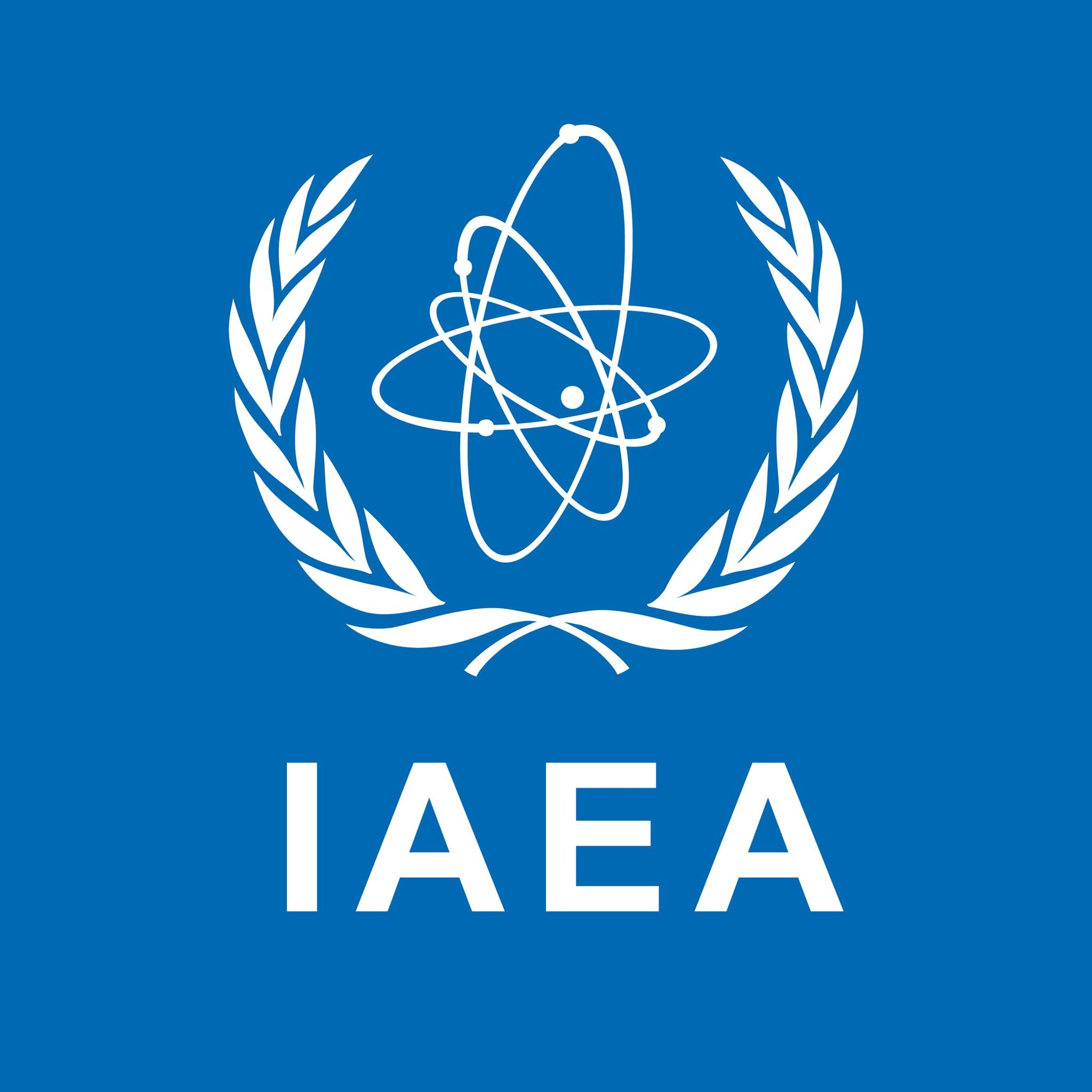
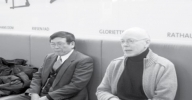
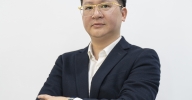
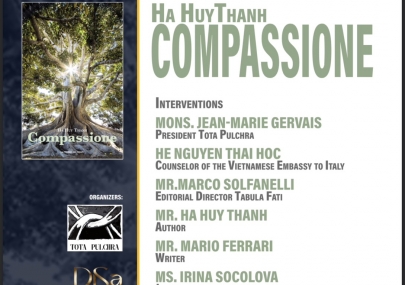

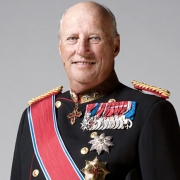








Comment